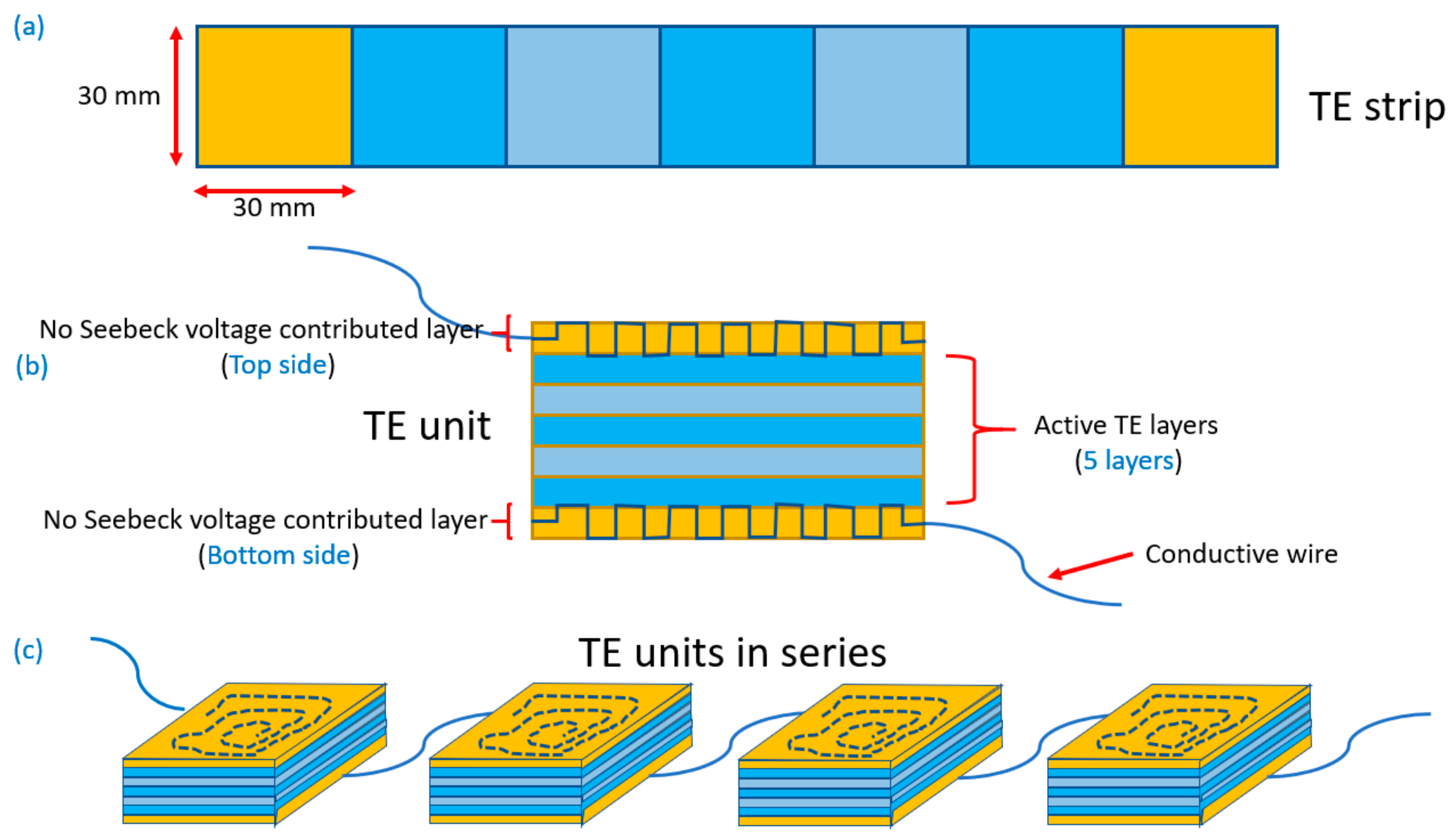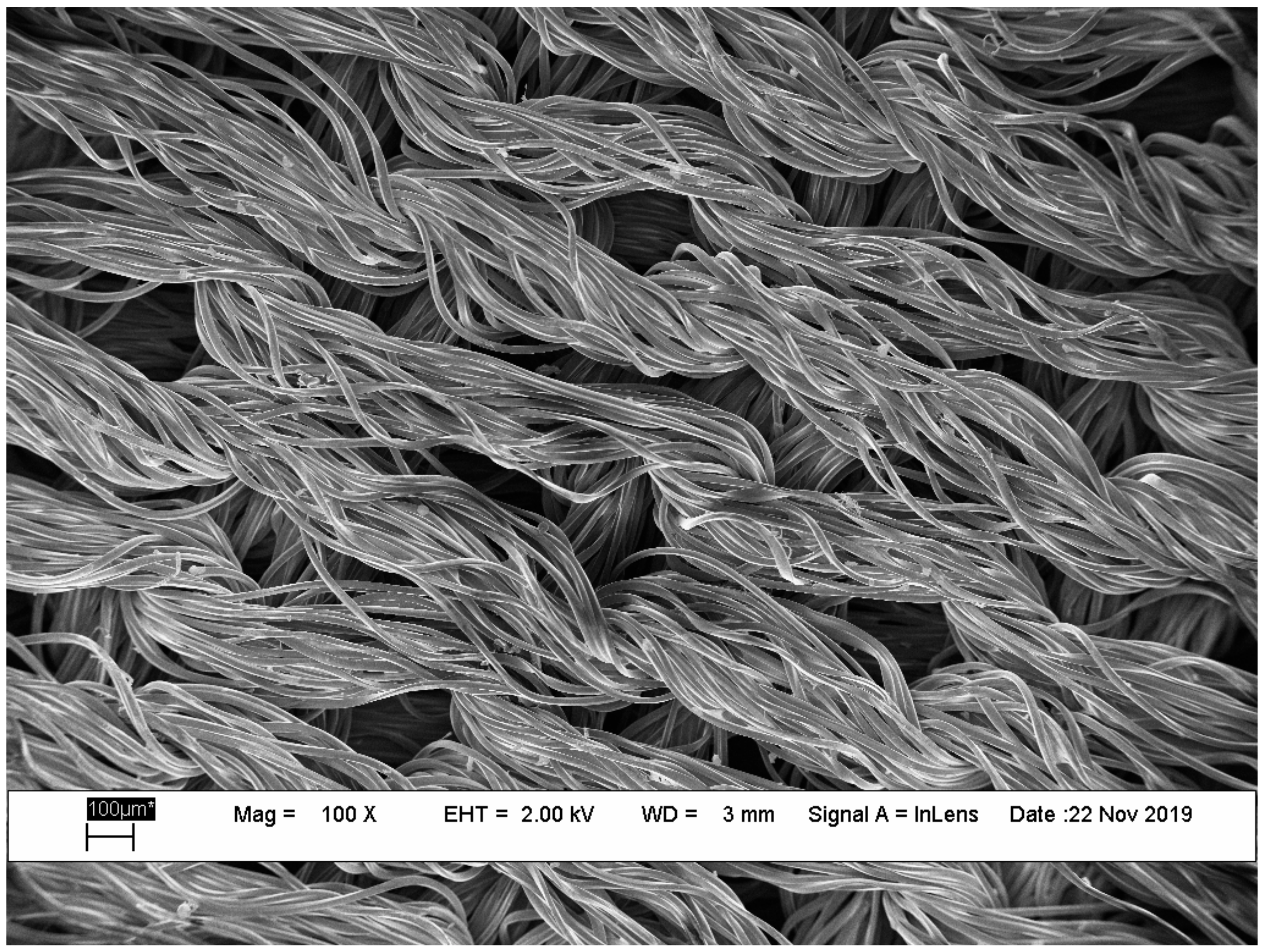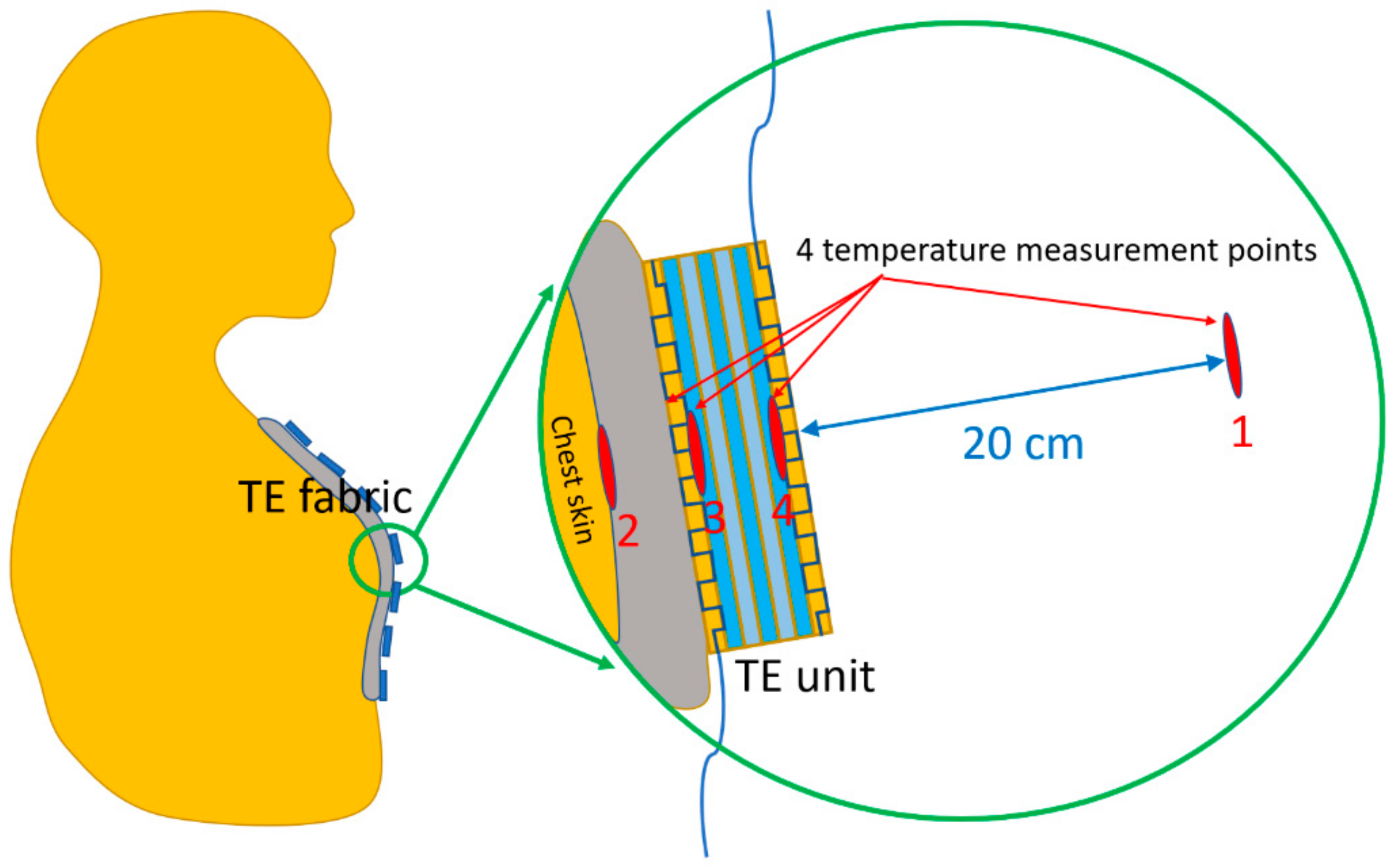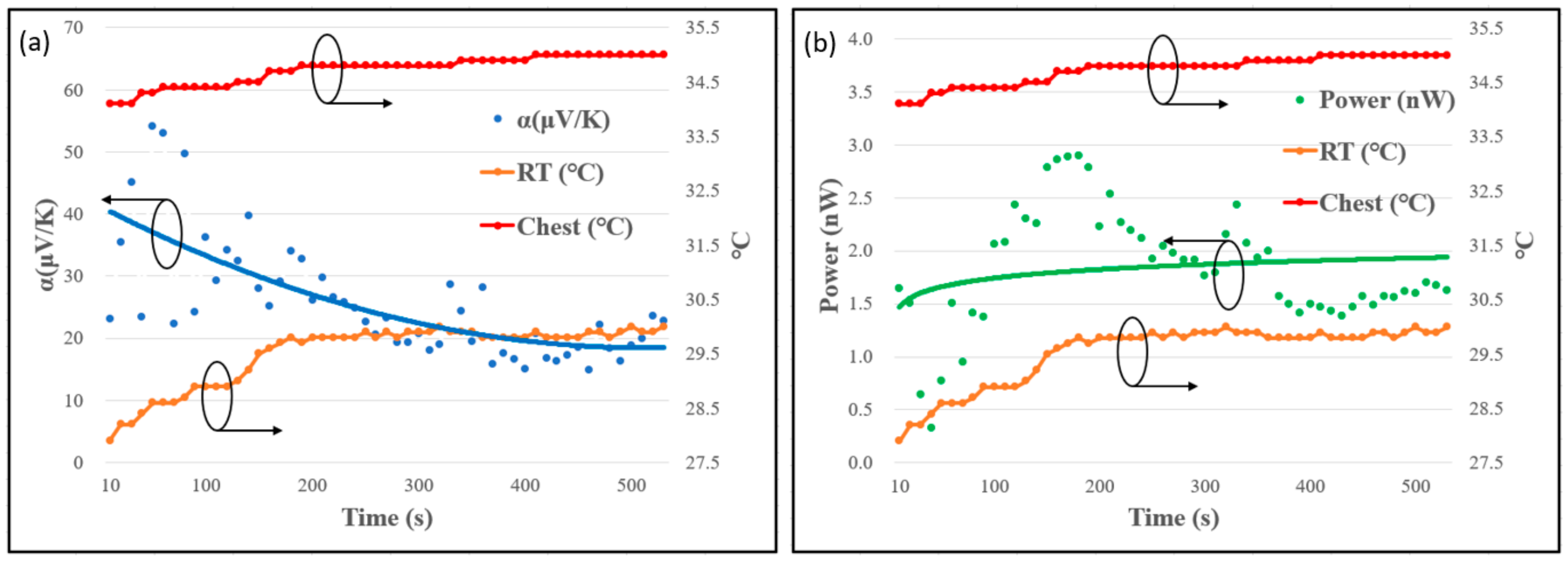Large-Area Laying of Soft Textile Power Generators for the Realization of Body Heat Harvesting Clothing
Abstract
1. Introduction
2. Materials and Method
2.1. Materials
2.2. Instruments and Equipment
2.3. Sample Preparation
3. Result and Discussion
4. Conclusions
Author Contributions
Funding
Conflicts of Interest
References
- Park, H.J.; Kim, D.G.; Eom, Y.M.; Dimuthu, W.; Kim, W. Flexible thermoelectric system based on inorganic bulk materials. In Journal of Physics: Conference Series; IOP Publishing: Bristol, UK, 2018; p. 012134. [Google Scholar]
- Leonov, V. Thermoelectric energy harvesting of human body heat for wearable sensors. IEEE Sens. J. 2013, 13, 2284–2291. [Google Scholar] [CrossRef]
- Siddique, A.R.M.; Mahmud, S.; Van Heyst, B. A review of the state of the science on wearable thermoelectric power generators (TEGs) and their existing challenges. Renew. Sustain. Energy Rev. 2017, 73, 730–744. [Google Scholar] [CrossRef]
- Lin, J.M.; Chen, Y.C.; Lin, C.P. Annealing effect on the thermoelectric properties of Bi2Te3 thin films prepared by thermal evaporation method. J. Nanomater. 2013, 2013, 1. [Google Scholar]
- Chen, A.; Madan, D.; Mahlstedt, B.T.; Wrigut, P.K.; Evans, J.W. Dispenser-printed thick film thermoelectric materials. In Proceedings of the PowerMEMS, Leuven, Belgium, 30 November–3 December 2010; pp. 223–226. [Google Scholar]
- Cao, Z.; Koukharenko, E.; Torah, R.N.; Beeby, S.P. Exploring screen printing technology on thermoelectric energy harvesting with printing copper-nickel and bismuth-antimony thermocouples. In Proceedings of the 2013 Transducers & Eurosensors XXVII: The 17th International Conference on Solid-State Sensors, Actuators and Microsystems (TRANSDUCERS & EUROSENSORS XXVII), Barcelona, Spain, 16–20 June 2013; IEEE: Piscataway, NJ, USA, 2013; pp. 478–481. [Google Scholar]
- Jiao, F.; Di, C.; Sun, Y.; Sheng, P.; Xu, W.; Zhu, D. Inkjet-printed flexible organic thin-film thermoelectric devices based on p-and n-type poly (metal 1, 1, 2, 2-ethenetetrathiolate) s/polymer composites through ball-milling. Philos. Trans. R. Soc. A Math. Phys. Eng. Sci. 2014, 372, 20130008. [Google Scholar] [CrossRef] [PubMed]
- Weber, J.; Potje-Kamloth, K.; Haase, F.; Detemple, P.; Volklein, F.; Doll, T. Coin-size coiled-up polymer foil thermoelectric power generator for wearable electronics. Sens. Actuators A Phys. 2006, 132, 325–330. [Google Scholar] [CrossRef]
- Glatz, W.; Schwyter, E.; Durrer, L.; Hierold, C. Bi2Te3-Based Flexible Micro Thermoelectric Generator with Optimized Design. J. Microelectromechanical Syst. 2009, 18, 763–772. [Google Scholar] [CrossRef]
- Yue, R.; Xu, J. Poly (3, 4-ethylenedioxythiophene) as promising organic thermoelectric materials: A mini-review. Synth. Met. 2012, 162, 912–917. [Google Scholar] [CrossRef]
- Tsai, T.-C.; Chang, H.-C.; Chen, C.-H.; Whang, W.-T. Widely variable Seebeck coefficient and enhanced thermoelectric power of PEDOT: PSS films by blending thermal decomposable ammonium formate. Org. Electron. 2011, 12, 2159–2164. [Google Scholar] [CrossRef]
- Norris, K.J.; Garrett, M.P.; Zhang, J.; Coleman, E.; Tompa, G.S.; Kobayashi, N.P. Silicon nanowire networks for multi-stage thermoelectric modules. Energy Convers. Manag. 2015, 96, 100–104. [Google Scholar] [CrossRef]
- Tan, R.; Yang, X.; Shen, Y. Robot-aided electrospinning toward intelligent biomedical engineering. Robot. Biomim. 2017, 4, 17. [Google Scholar] [CrossRef] [PubMed]
- Sarabi, G.A.; Latifi, M.; Bagherzadeh, R. Align and random electrospun mat of PEDOT: PSS and PEDOT: PSS/RGO. AIP Conf. Proc. 2018, 1920, 020045. [Google Scholar] [CrossRef]
- Cheng, H.; Du, Y.; Wang, B.; Mao, Z.; Xu, H.; Zhang, L.; Zhong, Y.; Jiang, W.; Wang, L.; Sui, X. Flexible cellulose-based thermoelectric sponge towards wearable pressure sensor and energy harvesting. Chem. Eng. J. 2018, 338, 1–7. [Google Scholar] [CrossRef]
- Kim, M.K.; Lee, S.; Kim, C.; Kim, Y.-J. Wearable thermoelectric generator for harvesting human body heat energy. Smart Mater. Struct. 2014, 23, 105002. [Google Scholar] [CrossRef]
- Novak, T.G.; Kim, K.; Jeon, S. 2D and 3D nanostructuring strategies for thermoelectric materials. Nanoscale 2019, 11, 19684–19699. [Google Scholar] [CrossRef] [PubMed]
- Paul, B.; LuPer, J.; Eklund, P. Nanostructural tailoring to induce flexibility in thermoelectric Ca3Co4O9 thin films. ACS Appl. Mater. Interfaces 2017, 9, 25308–25316. [Google Scholar] [CrossRef] [PubMed]
- Liang, J.; Wang, T.; Qiu, P.; Yang, S.; Ming, C.; Chen, H.; Song, Q.; Zhao, K.; Wei, T.-R.; Ren, D.; et al. Flexible thermoelectrics: From silver chalcogenides to full-inorganic devices. Energy Environ. Sci. 2019, 12, 2983–2990. [Google Scholar] [CrossRef]
- Yang, C.; Souchay, D.; Kneiß, M.; Bogner, M.; Wei, H.M.; Lorenz, M.; Oeckler, O.; Benstetter, G.; Fu, Y.Q.; Grundmann, M.; et al. Transparent flexible thermoelectric material based on non-toxic earth-abundant p-type copper iodide thin film. Nat. Commun. 2017, 8, 16076. [Google Scholar] [CrossRef] [PubMed]
- Lin, Z.; Hollar, C.; Kang, J.S.; Yin, A.; Wang, Y.; Shiu, H.-S.; Huang, Y.; Hu, Y.; Zhang, Y.; Duan, X.; et al. A Solution Processable High-Performance Thermoelectric Copper Selenide Thin Film. Adv. Mater. 2017, 29, 1606662. [Google Scholar] [CrossRef] [PubMed]
- Varghese, T.; Dun, C.; Kempf, N.; Saeidi-Javash, M.; Karthik, C.; Richardson, J.; Hollar, C.; Estrada, D.; Zhang, Y. Flexible Thermoelectric Devices of Ultrahigh Power Factor by Scalable Printing and Interface Engineering. Adv. Funct. Mater. 2019. [Google Scholar] [CrossRef]








© 2019 by the authors. Licensee MDPI, Basel, Switzerland. This article is an open access article distributed under the terms and conditions of the Creative Commons Attribution (CC BY) license (http://creativecommons.org/licenses/by/4.0/).
Share and Cite
Chen, Y.-S.; Lwo, B.-J. Large-Area Laying of Soft Textile Power Generators for the Realization of Body Heat Harvesting Clothing. Coatings 2019, 9, 831. https://doi.org/10.3390/coatings9120831
Chen Y-S, Lwo B-J. Large-Area Laying of Soft Textile Power Generators for the Realization of Body Heat Harvesting Clothing. Coatings. 2019; 9(12):831. https://doi.org/10.3390/coatings9120831
Chicago/Turabian StyleChen, Yao-Shing, and Ben-Je Lwo. 2019. "Large-Area Laying of Soft Textile Power Generators for the Realization of Body Heat Harvesting Clothing" Coatings 9, no. 12: 831. https://doi.org/10.3390/coatings9120831
APA StyleChen, Y.-S., & Lwo, B.-J. (2019). Large-Area Laying of Soft Textile Power Generators for the Realization of Body Heat Harvesting Clothing. Coatings, 9(12), 831. https://doi.org/10.3390/coatings9120831



